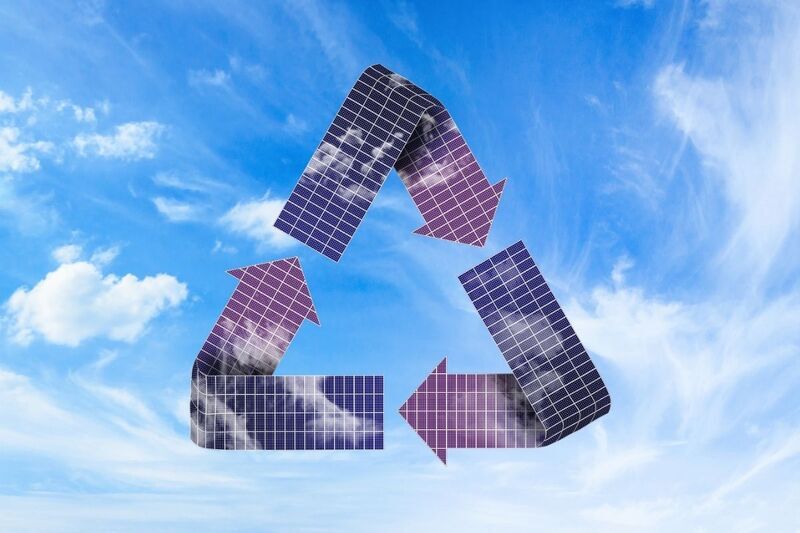
Report highlights 2 Egyptian projects among major clean energy ventures in N.Africa
A report by Energy Capital & Power highlighted two Egyptian projects – Suez Wind Power ...

We are now starting to see older installed solar panels being upgraded with newer more efficient panels as well as solar panels that are reaching the end of their useful life.
At the same time, the use of solar panels has increased and continues to increase rapidly meaning that there will soon be a significant number of solar panels flooding the system of disposal. Solar panels often contain lead, cadmium, and other toxic chemicals that cannot be removed without breaking apart the entire panel. Even the glass has impurities including plastics, lead, cadmium, and antimony. To date, many solar panels wind up in landfills where, over time, they can leach contaminants into the environment. Clearly, something needs to be accomplished to avoid this wave of solar panel disposal.
Solar panels can be recycled, but the costs and the possible environmental impacts have stood to bar efficient and widespread recycling. As of Jan. 1, a new California law became effective allowing for the management of decommissioned solar panels through recycling which will make recycling far more economical than before. This first-in-the-nation law will allow solar panels to be handled as “universal waste” as opposed to “hazardous waste” if the panels are solely being disposed of for recycling. Until now, the recycling of solar panels has been a marginally profitable activity, with transportation and handling costs being a substantial factor in the lack of profitability. Shifting the transportation and handling from hazardous waste to universal waste significantly reduces those costs, thus boosting the profitability of recycling and encouraging more recyclers to become involved in this effort.
A material that is deemed hazardous waste must be handled following a series of strict rules. What is and what is not hazardous is outlined in various rules and regulations promulgated under the Resource Conservation and Recovery Act (RCRA). Under RCRA, waste can be deemed hazardous if it is listed as a waste under the Act or meets the four characteristics of hazardous waste: ignitability, reactivity, corrosivity, and toxicity. The Act gives the EPA authority to make determinations and set rules regarding the generation, transportation, treatment, storage, and disposal of hazardous waste. To achieve this, the EPA has provided and continues to provide further regulations, guidance, and policies that ensure the safe management and cleanup of hazardous waste, and programs that encourage source reduction and beneficial reuse. For example, the EPA has set up standards applicable to generators of hazardous waste, for those to transport hazardous waste, for those who store or dispose of hazardous waste, and others. But, when RCRA was written, it was Congress’ intent for the states to assume primary responsibility for implementing the hazardous waste regulations, with oversight from the federal government. Congress felt the states’ familiarity with the regulated community, and state and local needs would allow them to administer the hazardous waste program in the most effective manner. For a state to assume the regulatory lead as the implementing agency, it must be authorized by EPA to do so.
The standards applicable to a generator of hazardous waste include various classifications, each with different sets of criteria for compliance. However, whether considered small or large, each generator must comply with the program of waste manifesting which, in essence, shows what the substance was, how much of it existed, who generated it, who is transporting it to a specific facility approved for handling such material, etc. There are also various requirements for storage, packaging, and record keeping. This makes the cost of handling hazardous substances expensive and sometimes very cumbersome.
On the other hand, a universal waste is not so burdened with the various aspects of compliance as with hazardous substances, but of course, there are regulatory standards to be met as these wastes still contain hazardous substances. As with hazardous wastes, there are different requirements for small and large generators and various important protocols that must be met to store, transport, and dispose of universal waste.
The EPA promulgated the universal waste program in May 1995. Originally, there were only three types of wastes covered under the universal waste regulations: hazardous waste batteries, hazardous waste pesticides that are either recalled or collected in waste pesticide collection programs, and hazardous waste thermostats. Since then hazardous waste lamps were added to the list. This list is not all-inclusive as states such as California have qualified to be the regulatory lead under RCRA. California maintains seven categories of hazardous wastes that can be managed as universal wastes. Any unwanted item that falls within one of these waste streams can be handled, transported, and recycled by following the requirements outlined in the universal waste regulations found at Cal. Code Regs, title 22, division 4.5, chapter 23.
Before solar panels were added, universal wasters in California were:
Under California’s new regulation, solar panels are subject to a set of rules to promote recycling. For example, solar panels may be accumulated for up to one year, while the general hazardous waste requirements generally allow accumulation for 90 days. This allows a longer time to accumulate enough solar panels to make transportation in bulk instead of a more frequent basis, which brings the cost per capita down. Along with the universal waste requirements of less labeling and record keeping, the ability to transport without a hazardous waste manifest adds to the lower cost per solar panel for recycling.
Over time, additional benefits may arise from this streamlined system that are not yet foreseen or calculated. Clearly, the benefits of this program will boost recycling activity in California, and if successful, jump start solar panel recycling in other states.
A report by Energy Capital & Power highlighted two Egyptian projects – Suez Wind Power ...
The opening concert of the Annual Meeting 2025 in Davos-Klosters will address the pressing issues ...
Juhayna Food Industries proudly announced that its agricultural arm, El Enmaa for Agricultural Development, has ...


اترك تعليقا